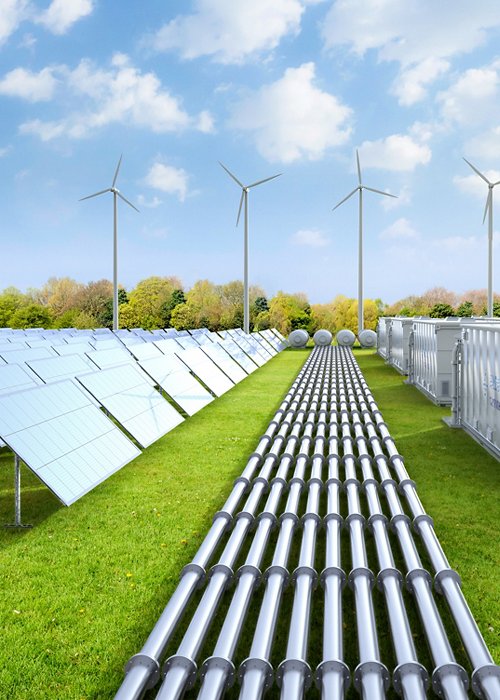The Renewable Energy Policy Network for the 21st Century (Ren21) periodically publishes data and statistics on the market, industry, investments, and policies concerning renewable sources worldwide. These data are illustrated and analysed in the "Renewables 2024 Global Status Report" (https://www.ren21.net/gsr-2024/) , which this year reaches its nineteenth edition. The release of the report allows us to outline the current state of renewable energy globally, a sector in constant development and change.
Analysing the report's data for 2023 reveals that renewable energy is on the path of recovery and growth, despite continued disparities between technologies and regions. The energy crisis of the previous year has continued to ease, and there has been a significant increase in solar photovoltaics, followed by wind energy, along with a marked rise in energy investments. Global installed capacity increased by about 36% in 2023, reaching approximately 473 gigawatts (GW), setting a new record for the 22nd consecutive year. Notably, solar photovoltaics led the rise in global capacity, accounting for three-quarters of all new installations. In fact, 98% of new installations in 2023 came from solar photovoltaics and wind energy.
The United States saw a significant growth only in solar photovoltaics, with total installed capacity increasing by more than 50% compared to the previous year, reaching nearly 33 GW, while wind energy registered its lowest growth in the past decade. In the European Union (EU), photovoltaic capacity increased from 41 GW installed in 2022 to 56 GW in 2023, and wind energy added 17 GW to the European wind park in 2023, a slight increase from 2022. China continued to dominate the renewable energy sector, installing in 2023 an amount of GW equivalent to the total global solar photovoltaic installations in 2022. China also invested in about 30 GW of offshore wind energy, representing roughly half of the global capacity. These developments in renewables were offset by a sharp increase in Chinese energy consumption; in 2023, alongside the growth in renewables, the country invested in 114 GW of coal energy, up 10% from 2022. Regarding solar energy, in the decade between 2013 and 2023, production increased tenfold globally, driven by the growing demand for clean energy and industrial policies that have enabled economies of scale and stimulated demand. Solar energy plants are not evenly distributed worldwide; in fact, 90% of global capacity is concentrated in just five countries: China leads with about 80% of the total global solar photovoltaic capacity, followed by Vietnam, India, Malaysia, and Thailand.
Renewable Energy Successes
The evolution of renewable energy in recent years has exceeded all expectations; global installed capacity and energy production have increased significantly, and since the early 2000s, there has been a trend of increased investments and policies supporting renewable energy. The energy and economic crises of recent years, along with the growing focus and commitment to mitigating climate change, have been the driving forces behind this rapid development, surpassing all growth forecasts. Moreover, some pioneering countries in the renewable energy sector, such as Germany, Denmark, Spain, and the United States, laid the groundwork for the first technological advancements, triggering exponential growth in the renewable energy market.
Technology’s progress and renewables’ rapid development, particularly in the electricity sector, have clearly demonstrated their potential. Today, renewable technologies are not only seen as tools to improve energy security and mitigate and adapt to climate change, but they are also increasingly recognized as investments capable of providing direct and indirect economic benefits. For example, they reduce dependency on the importation of traditional fossil fuels, contribute to improved local air quality, increase access to energy in rural areas, and help create new jobs. The sector with the highest growth has been electricity generation.
What About the Future?
Renewable energy is a key driver of social, political, and economic growth, as it provides significant benefits such as greater access to energy, improved health, social equality, and job creation. Furthermore, renewables enhance energy security in countries with little or no internal supply of fossil fuels, reducing reliance on imports of traditional energy sources. Finally, they help limit greenhouse gas emissions produced by the energy sector. In light of this and to achieve the goal of doubling the share of renewable energy by 2030, as established by the "Sustainable Energy for All" program (https://www.seforall.org ) promoted by the UN Secretary-General, it is necessary to at least triple all forms of modern renewable energy. Even more importantly, a change in the "business-as-usual" approach to energy supply is required, ensuring that issues of energy demand and supply are addressed simultaneously.
At the 2023 UN Climate Conference in Dubai, United Arab Emirates (COP 28), the outcome for the renewable energy sector was complex. In particular, renewables and energy efficiency were mentioned in the final conference text in line with global efforts to achieve sustainable goals in terms of climate, energy, and the economy. For the first time, countries agreed on the need to "transition from fossil fuels to renewable energy." In a key commitment at COP 28, 130 countries pledged to triple the world's renewable energy capacity and double the annual rate of improvements in energy efficiency by 2030 in an attempt to limit global warming to 1.5°C above pre-industrial levels by the end of the century. The signatories collectively represented 40% of global CO2 emissions from fossil fuel combustion, 37% of emissions from global energy demand, and 56% of global GDP. However, China and India, two of the largest greenhouse gas emitters, were not among the participants in the pledge.
While energy security concerns have accelerated the transition to renewable energy and energy efficiency in some countries, many nations continue to invest in fossil fuels, including coal, as a guarantee for energy supply. Many developing countries have also prioritized short-term economic growth over long-term energy transition. This trend has challenged the development of the renewable energy sector, despite technological advancements and increasing awareness of environmental concerns. Progress in implementing policies and investments in renewable energy worldwide remains geographically uneven, highlighting the ongoing issue of energy inequality. Finally, the supply of critical minerals such as lithium and cobalt is limited to the few countries that extract these resources, posing a risk to future renewable energy implementations.




